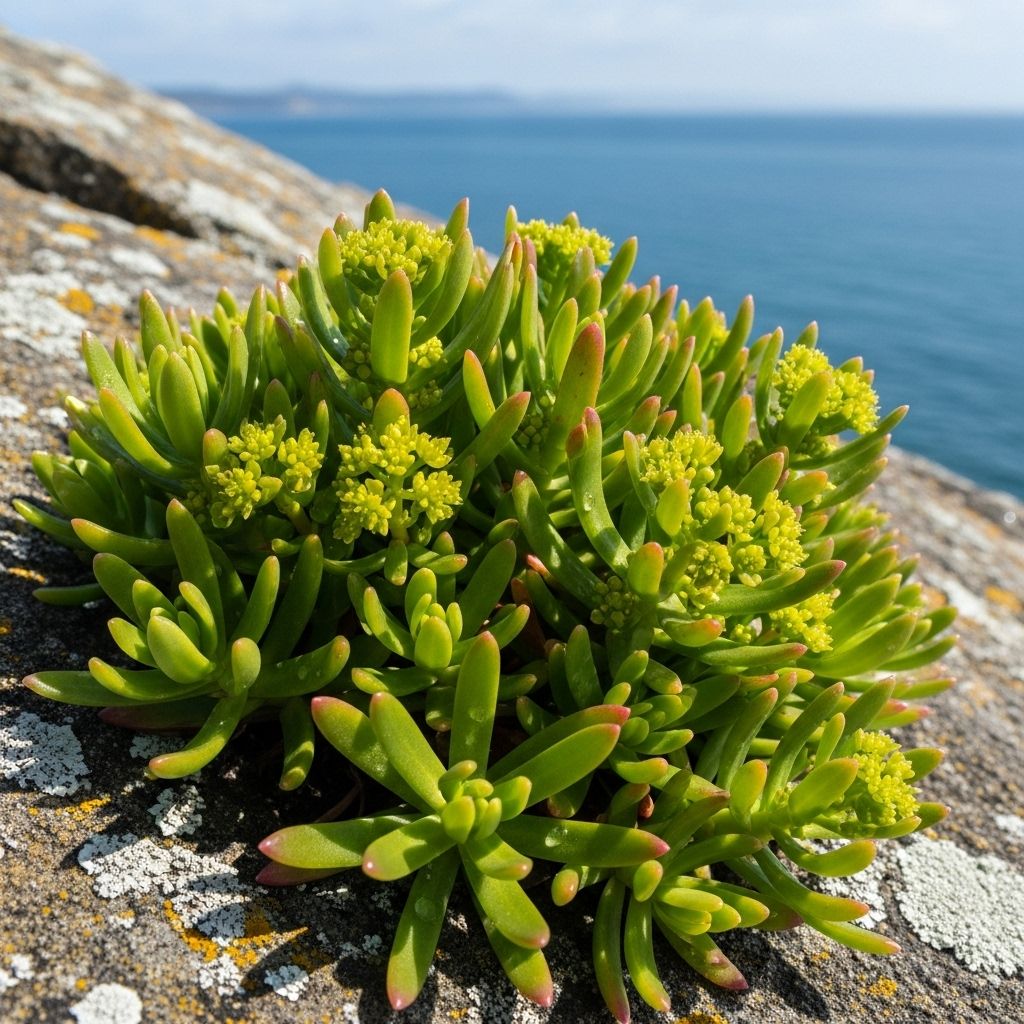Understanding Rock Samphire: Benefits, Uses, and Taste
Briny, ferny greens invite inventive twists from coastal salads to homemade pickles.

Introduction to Rock Samphire
Rock samphire, also known as sea fennel or Crithmum maritimum, is a perennial plant belonging to the Apiaceae family. It is renowned for its striking appearance and historical significance, particularly in coastal areas of Europe. This plant has been a favorite among foragers, chefs, and nature enthusiasts due to its unique taste and adaptability to harsh marine environments.
Physical Characteristics of Rock Samphire
Rock samphire is characterized by its blue-green, deeply lobed leaves that resemble small palm fronds or ferns. The leaves and stems are fleshy and succulent, allowing the plant to thrive in salt-infused soils and withstand strong coastal winds. During the summer, it produces small clusters of yellow-green flowers arranged in umbels, which add vibrancy to its coastal habitat.
Key Features for Identification
- Habit: Rock samphire grows low to the ground, forming dense clumps or spreading along the coastline, typically reaching 20-60 cm in height.
- Leaves: Fleshy, succulent, and deeply lobed with a blue-green color, resembling small palm fronds or fern leaves.
- Stems: Also fleshy and succulent, often branching out and sprawling along the ground or rocks.
- Flowers: Small clusters of yellow-green flowers with five petals, arranged in umbels.
- Habitat: Found in coastal areas, particularly in the intertidal zone, on cliffs, rocks, and shingle beaches.
Culinary Uses and Taste
Rock samphire is highly valued for its culinary uses. The leaves are eaten raw or cooked and have a strong, salty flavor with a hint of bitterness, somewhat reminiscent of fennel. They are often used as a seasoning in salads or pickled for later consumption. The young leaves are gathered in the spring and boiled with salt to make a flavorful pickle. The seed pods can be used to create aromatic pickles, adding an exciting flavor to dishes.
Preparation Ideas
- Raw Salads: Add fresh rock samphire leaves to salads for a burst of citrusy flavor.
- Pickling: Young leaves can be pickled in vinegar and spices for a side dish or used as a garnish.
- Cooked Dishes: Use rock samphire in soups, stews, or as a side vegetable with roasted meats.
Health Benefits and Medicinal Uses
Rock samphire is not only a culinary delight but also offers several health benefits. It is rich in vitamin C, which historically helped prevent scurvy. The plant is considered a diuretic and aids in digestion, relieving flatulence and acting as a carminative. Its high mineral content and low caloric value make it beneficial for weight loss.
Specific Health Benefits
- Rich in Vitamins and Minerals: Supports immune function and overall health.
- Antioxidant Properties: Helps protect against oxidative stress and inflammation.
- Cardiovascular Health: May reduce the risk of heart disease due to its antioxidant and diuretic properties.
Growing Rock Samphire
Rock samphire thrives in coastal environments with saline conditions, requiring well-drained soils. While it is native to coastal areas, it can be cultivated inland in gardens with specific soil conditions. It prefers light sandy or gravelly soils and can grow well in rocky areas, especially between stones.
Cultivation Tips
- Soil Requirements: Saline conditions or well-drained, poor, dry soil for inland cultivation.
- Lighting: Prefers full sun to partial shade.
- Watering: While it’s adapted to salt spray, it should not be overwatered when cultivated.
Conclusion
Rock samphire is a fascinating plant with a rich history, culinary appeal, and numerous health benefits. Its unique taste and adaptability make it a sought-after ingredient in coastal cuisine, while its medicinal properties offer potential health advantages. Whether foraged from the wild or cultivated with care, rock samphire is a coastal delicacy worth exploring.
Frequently Asked Questions (FAQs)
Q: What does rock samphire taste like?
A: Rock samphire has a strong, salty, and slightly bitter flavor, somewhat reminiscent of fennel.
Q: How is rock samphire used in cooking?
A: It is often used raw in salads, pickled, or cooked in soups and stews.
Q: What are the health benefits of rock samphire?
A: It is rich in vitamin C, aids digestion, acts as a diuretic, and may have antioxidant properties.
References
- https://www.wildfoodie.co.uk/post/rock-samphire-intriguing-sea-vegetable
- https://specialtyproduce.com/produce/Rock_Samphire_25063.php
- https://pfaf.org/user/Plant.aspx?LatinName=Crithmum+maritimum
- https://warndu.com/blogs/first-nations-food-guide/samphire-the-asparagus-of-the-sea
- https://en.wikipedia.org/wiki/Crithmum
- https://blog.metmuseum.org/cloistersgardens/2012/09/07/rock-samphire/
- https://botsoc.scot/2025/08/24/plant-of-the-week-august-25th-2025-rock-samphire-crithmum-maritimum/
- https://www.richardjacksonsgarden.co.uk/rock-samphire/
- https://www.sofiaskaleidoscope.com/journal/rock-samphire/
Read full bio of Sneha Tete












